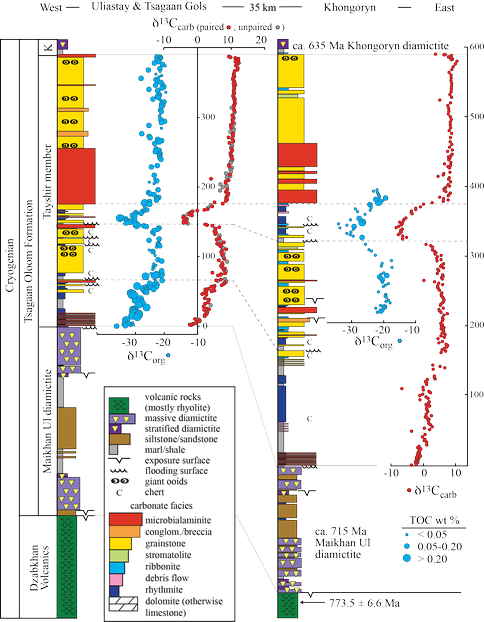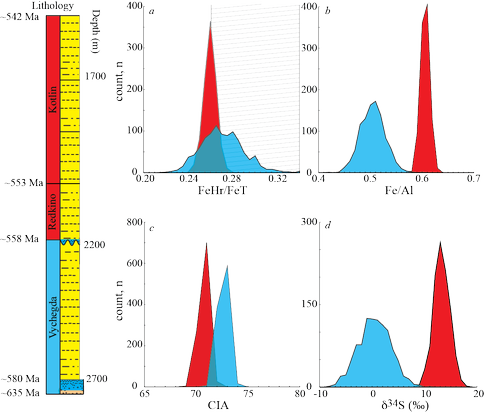2012 Annual Science Report
 Massachusetts Institute of Technology
Reporting | SEP 2011 – AUG 2012
Massachusetts Institute of Technology
Reporting | SEP 2011 – AUG 2012
Atmospheric Oxygen and Complex Life
Project Summary
Our team is working to understand what the world looked like just before and just after the evolution of animals. This encompasses field geology (identifying rocks of that age), chemical analysis of those rocks, and close examination of the small, enigmatic fossilized forms within those same geologic units. To synthesize these interdisciplinary approaches, our team also works to contribute overview/review papers that speak to the contribution from each field.
Project Progress
The Mesoproterozoic Era is widely thought to be quite “boring,” whereas the subsequent Neoproterozoic is characterized by large perturbations to geochemical cycles, climate instability, a putative rise of oxygen, and eukaryotic radiation. We seek to understand the cause and timing of the onset of volatile geochemical cycling that is characteristic of the Neoproterozoic. Large isotopic variability during the Neoproterozoic has previously been proposed to be the product of alteration (Knauth and Kennedy, 2009) or dynamic behavior of a large dissolved organic carbon pool (Rothman et al., 2003). Through our stratigraphic and geochemical studies in Mongolia we identified a large Cryogenian carbonate carbon isotope anomaly that covaries in organic carbon isotopes (Johnston et al., 2012). Although these data exclude these previous hypotheses for large carbon isotopic variability during the Neoproterozoic, we still do not understand what is driving the apparent temporal variability in the carbon cycle. In Mongolia we have begun to layer trace element, clay minerology, and biostratigraphy onto these isotopic records. All of these data suggest a major change across the Tayshir anomaly from marine, weakly oxidized conditions, to anoxic, potentially non-marine conditions. Late Neoproterozoic (Ediacaran) strata from around the globe carry evidence for a biospheric revolution that is long thought to carry a genetic link to atmospheric oxygen. Fortunately, these classic models can now be tested with an expanding toolbox of geochemical techniques and ever improving stratigraphic frameworks. Here we focus on new storylines emerging from northwest Canada and place these data in the context of published chemostratigraphy from other localities.
Northwest Canada holds one of the classic localities for the study of early animal life, and as such, provides an opportunity to directly test hypotheses discussed above for Mongolia and more broadly about evolving environments (biological and chemical). More specifically, recently submitted work on a detailed geochemical reconstruction of the Wernecke Mountains, Yukon (Johnston et al., submitted). Given recent stratigraphic studies (Macdonald et al., submitted), we are able to extend these records to the Ogilvie Mountains to the west and Mackenzie Mountains to the east. What emerges from a multiproxy (Fe speciation, sulfur isotopes, major and trace elements analyses) reconstruction is a picture of a persistently anoxic and ferruginous Ediacaran ocean, despite a major change in sediment protolith up-section and an increasing prevalence of Fe-bearing illite. Our work in the Wernecke Mountains is set against a composite δ13C record for carbonate that preserves three distinct Ediacaran isotope excursions, the lowermost of which (preserved in the Gametrail Formation) is a putative Shuram anomaly equivalent. Notably absent is geochemical evidence for a prominent oxygenation event, an expectation given the appearance of animals and large swings in δ13C. The new insight gained through the integration of these data further challenge the idea of a dramatic Ediacaran jump in atmospheric oxygen, which in turn muddles the link between animal evolution and local geochemical environments. In many ways, these data are consistent with that which we find in Mongolia.
Older stratigraphic units exposed in northwest Canada allow for similar tests of global coherence with Mongolia and other continents. The Proterozoic record of the northwestern Canadian Cordillera is an attractive place to explore the Mesoproterozoic to Neoproterozoic transition because there are several well-exposed, low-grade, mixed carbonate siliclastic successions that were deposited between 1.5 and 0.7 Ga. Correlations of Proterozoic strata have been recently revisited and refined with new mapping, geochemistry, and stratigraphic analysis, and geochronology and have identified an additional late Mesoproterozoic to early Neoproterozoic succession between Sequence A and Sequence B of Young (1979, 1981). These rocks of the Pinguicula, Hematite Creek, and lower Fifteenmile groups are situated between the geochemically well-characterized 1.5 to 1.27 Ga Dismal Lake Group and the 0.81 Ga upper Fifteenmile Group (and coeval Little Dal Group). This season we mapped the geology and collected samples through measured sections in the early Neoproterozoic Hematite Creek Group and in the Cryogenian Keele Formation. These data will allow us to construct higher resolution paleontological and geochemical records across the Mesoproterozoic-Neoproterozoic transition and the Cryogenian glacial interlude, and assess the relationship between oxidation state, changes in the carbon cycle, glaciation, and the diversification of eukaryotes.
Chemostratigraphic sections through the Tayshir Member, Mongolia (interglacial). Red circles are paired with organic carbon isotopic compositions. Gray circles are unpaired carbonate values through the same section. The stratigraphic section to the right was measured 35 km to the northeast; a distance shortened by the Cambrian Altaid orogeny. Age constraints on the Dzabkhan volcanics. This is Figure 1 from Johnston et al., 2012a.
A statistical resampling of key geochemical metrics from the Ediacaran of Russia. Data sets were divided at the Vychegda-Redkino sequence boundary (Vychegda in blue, Redkino and Kotlin in red). Importantly, sampling of the Vychegda began at 2779 m, the bed at which distinctly Ediacaran acritarchs first appear. a) A measure of overall water column redox, FeHr/FeT. b) The relationship between Fe and Al. c) The chemical index of alteration. d) The isotopic composition of pyrite sulfur. In all cases, one thousand synthetic runs were performed (binned and recorded on ordinate axis). Ordinate axis scale changes from frame to frame. This is figure 6 from Johnston et al 2012b.
Publications
-
Bosak, T., Lahr, D. J. G., Pruss, S. B., MacDonald, F. A., Gooday, A. J., Dalton, L., & Matys, E. D. (2011). Possible early foraminiferans in post-Sturtian (716-635 Ma) cap carbonates. Geology, 40(1), 67–70. doi:10.1130/g32535.1
-
Chakrabarti, R., Knoll, A. H., Jacobsen, S. B., & Fischer, W. W. (2012). Si isotope variability in Proterozoic cherts. Geochimica et Cosmochimica Acta, 91, 187–201. doi:10.1016/j.gca.2012.05.025
-
Johnston, D. T., MacDonald, F. A., Gill, B. C., Hoffman, P. F., & Schrag, D. P. (2012). Uncovering the Neoproterozoic carbon cycle. Nature, 483(7389), 320–323. doi:10.1038/nature10854
-
Johnston, D. T., Poulton, S. W., Goldberg, T., Sergeev, V. N., Podkovyrov, V., Vorob’eva, N. G., … Knoll, A. H. (2012). Late Ediacaran redox stability and metazoan evolution. Earth and Planetary Science Letters, 335-336, 25–35. doi:10.1016/j.epsl.2012.05.010
-
Tziperman, E., Halevy, I., Johnston, D. T., Knoll, A. H., & Schrag, D. P. (2011). Biologically induced initiation of Neoproterozoic snowball-Earth events. Proceedings of the National Academy of Sciences, 108(37), 15091–15096. doi:10.1073/pnas.1016361108
-
- Gaidos, E. & Knoll, A.H. (2012). Our evolving planet: from the dark ages to an evolutionary renaissance. In: Lunine, J. & Impie, C. (Eds.). Astrobiology. Cambridge, UK: Cambridge University Press.
- Halverson, G.P., MacDonald, F.A., Strauss, J.V., Smith, E.F., Cox, G.M. & Hubert-Theou, L. (2011). Updated definition and correlation of the lower Fifteenmile Group in the central and eastern Ogilvie Mountains. In: MacFarlane, K.E. & Sack, P.J. (Eds.). Yukon Exploration Geology 2011. Whitehorse.
-
PROJECT INVESTIGATORS:
-
PROJECT MEMBERS:
Tanja Bosak
Project Investigator
David Johnston
Project Investigator
Andrew Knoll
Project Investigator
Francis Macdonald
Project Investigator
Phoebe Cohen
Postdoc
Ross Anderson
Undergraduate Student
-
RELATED OBJECTIVES:
Objective 4.1
Earth's early biosphere.
Objective 4.2
Production of complex life.
Objective 6.1
Effects of environmental changes on microbial ecosystems
Objective 6.2
Adaptation and evolution of life beyond Earth

